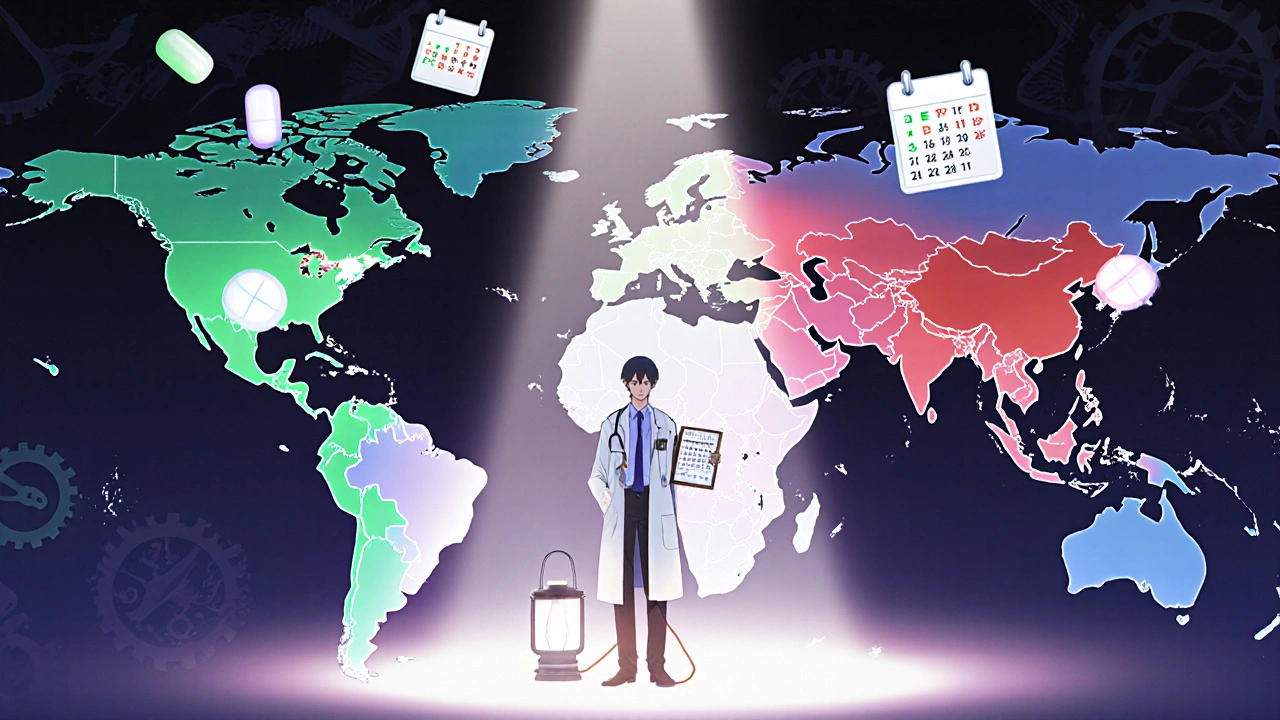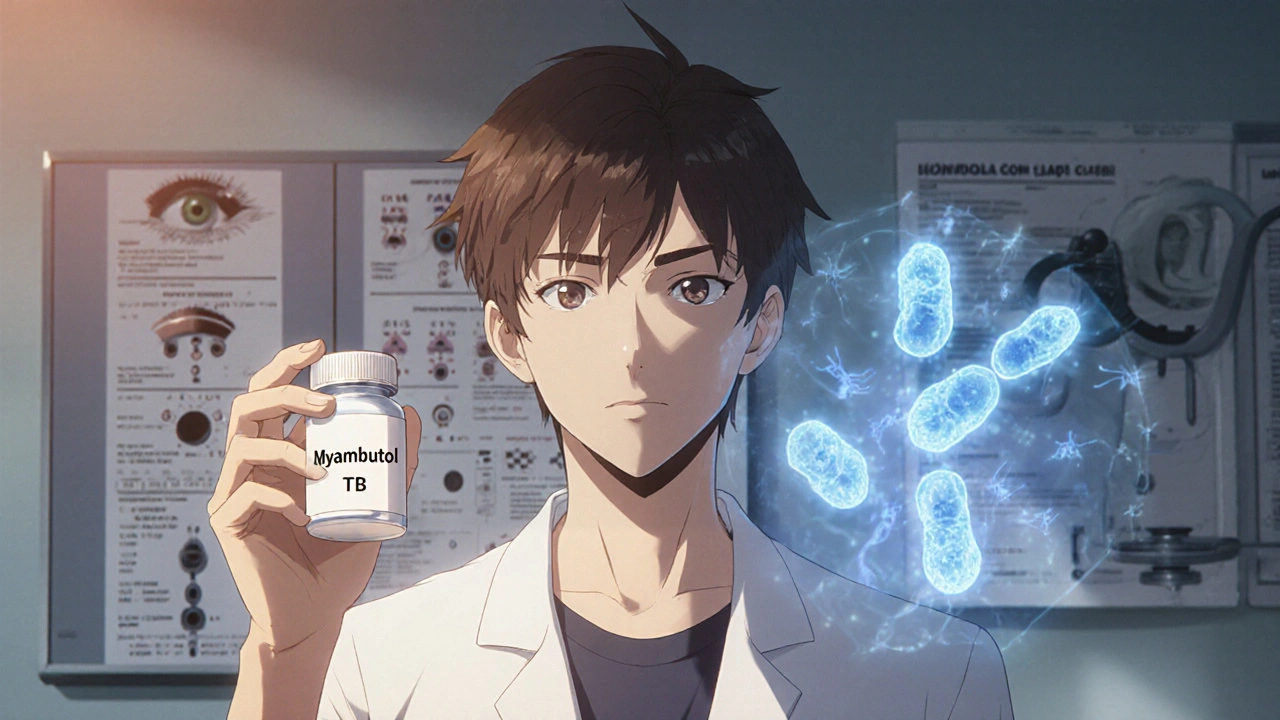TB Treatment Decision Assistant
Your TB Treatment Options
This tool helps you understand if Myambutol (ethambutol) is the right choice for your TB treatment based on your health profile and circumstances. It considers key factors like your age, eye health, HIV status, and TB history.
When you’re diagnosed with tuberculosis, your doctor doesn’t just pick one drug out of thin air. They build a treatment plan using a mix of medications that work together to kill the bacteria and prevent resistance. One of those key drugs is Myambutol - the brand name for ethambutol. But it’s not the only option. If you’ve been prescribed Myambutol and are wondering what else is out there, or if you’re experiencing side effects, you’re not alone. Many people ask: are there better alternatives? Safer ones? Cheaper ones? Let’s break down how Myambutol stacks up against other TB drugs used today.
What Myambutol (Ethambutol) Actually Does
Myambutol is a first-line antibiotic used specifically for tuberculosis. It doesn’t kill TB bacteria on its own - it stops them from building their cell walls. This weakens the bacteria so other drugs like isoniazid and rifampicin can finish the job. It’s usually part of a four-drug combo at the start of treatment, then sometimes dropped later if the infection responds well.
It’s taken orally, once a day. The standard adult dose is 15 mg per kg of body weight, so a 70 kg person would take about 1,050 mg daily. It’s not a drug you take for a few days - you take it for months. And while it’s generally well tolerated, it’s not without risks.
The biggest concern with ethambutol is optic neuritis - swelling of the optic nerve. This can cause blurred vision, trouble seeing colors (especially red and green), or even permanent vision loss if not caught early. That’s why doctors require baseline eye exams before starting and regular check-ups during treatment. It’s rare, but serious enough that you need to report any vision changes immediately.
First-Line Alternatives to Myambutol
The World Health Organization (WHO) and the CDC list four core first-line TB drugs: isoniazid, rifampicin, pyrazinamide, and ethambutol. These are the backbone of standard treatment. So if you’re looking for alternatives to Myambutol, you’re really asking: can one of the other three replace it?
The short answer: not really - not directly. Each of these drugs has a different job. Isoniazid attacks dormant bacteria. Rifampicin kills active ones. Pyrazinamide works best in acidic environments like inside lung cavities. Ethambutol is the only one that blocks cell wall synthesis in a way that helps prevent resistance during the early, aggressive phase of treatment.
That’s why guidelines still recommend ethambutol as part of the initial four-drug regimen. But there are exceptions.
When Ethambutol Might Be Skipped
In places where TB is highly sensitive to isoniazid and rifampicin - like in the UK, where drug resistance is low - some doctors may start with just three drugs: isoniazid, rifampicin, and pyrazinamide. This is called a 3-drug regimen. Studies from the UK Health Security Agency show that in low-resistance settings, skipping ethambutol doesn’t increase treatment failure rates, as long as the patient is closely monitored.
But this isn’t for everyone. If you’re HIV-positive, have had TB before, or came from a country with high drug resistance, ethambutol stays in the mix. Your doctor weighs your risk of resistance against your risk of side effects.
Second-Line Drugs: What Happens When Myambutol Doesn’t Work
What if you can’t take ethambutol because of vision problems? Or what if your TB strain is resistant to it? Then you move to second-line drugs. These are older, less convenient, and often harder on the body.
Here are the most common alternatives used when ethambutol isn’t an option:
- Streptomycin - an injectable antibiotic from the 1940s. It works well but can damage hearing and balance. Requires daily shots for the first 2-3 months. Rarely used today unless absolutely necessary.
- Levofloxacin - a fluoroquinolone. More modern, taken as a pill. It’s now a preferred second-line drug in many countries. Effective against resistant strains and doesn’t affect vision. Side effects include nausea, dizziness, and rarely tendon damage.
- Moxifloxacin - similar to levofloxacin but slightly more potent. Often used in shorter regimens being tested in clinical trials. Not yet standard everywhere.
- Cycloserine - an old drug that can cause serious neurological side effects like confusion, depression, or seizures. Used only when other options fail.
- Linezolid - originally for resistant skin infections. Now used for drug-resistant TB. Very effective but can cause anemia and nerve damage with long-term use. Requires monthly blood tests.
These drugs aren’t "better" than ethambutol - they’re backups. They’re used when ethambutol can’t be used. They’re more expensive, harder to tolerate, and require more monitoring.

Cost and Accessibility: How Location Changes Your Options
Myambutol is cheap. In the UK, a month’s supply costs less than £10 through the NHS. Generic ethambutol is available worldwide for under $1 per day in low-income countries.
Compare that to levofloxacin, which can cost over £50 a month in the UK without insurance. Linezolid? Around £200 per month. That’s why in places like India, Nigeria, or parts of Eastern Europe, ethambutol remains the go-to - not because it’s perfect, but because alternatives aren’t affordable or available.
If you’re in the UK or another high-income country, you have more choices. But if you’re traveling, living abroad, or accessing care through a clinic with limited resources, your options shrink fast. Your treatment plan isn’t just about what’s medically best - it’s about what’s practically possible.
Side-by-Side Comparison: Myambutol vs. Common Alternatives
Here’s how ethambutol stacks up against the most common alternatives in real-world use:
| Drug | Route | Typical Dose | Key Side Effects | Monitoring Required | Cost (UK NHS) |
|---|---|---|---|---|---|
| Myambutol (Ethambutol) | Oral | 15 mg/kg/day | Optic neuritis (vision loss) | Eye exams every 1-2 months | £5-£10/month |
| Isoniazid | Oral | 5 mg/kg/day | Liver damage, peripheral neuropathy | Liver enzymes monthly | £3-£8/month |
| Rifampicin | Oral | 10 mg/kg/day | Orange body fluids, liver stress | Liver enzymes monthly | £10-£15/month |
| Levofloxacin | Oral | 750 mg/day | Nausea, dizziness, tendon risk | None routine | £40-£60/month |
| Linezolid | Oral | 600 mg/day | Anemia, nerve damage | Blood tests every 2 weeks | £180-£220/month |
As you can see, ethambutol is one of the cheapest and most targeted options. But its vision risk makes it tricky for older adults or people with pre-existing eye conditions. Levofloxacin is a good substitute in those cases - but it’s far more expensive and not approved as a first-line drug in all guidelines.
Real-Life Scenarios: When to Choose What
Here’s how decisions actually play out:
- Healthy 30-year-old with no vision issues: Myambutol stays. Low cost, low risk, proven track record.
- 65-year-old with glaucoma: Myambutol is avoided. Levofloxacin or moxifloxacin replaces it. Eye exams aren’t needed, but heart rhythm checks might be.
- Someone with HIV and TB: Ethambutol is usually kept. Drug interactions are fewer than with fluoroquinolones.
- Drug-resistant TB: Ethambutol is out. Linezolid, bedaquiline, or clofazimine take over - even if they’re expensive or hard to take.
There’s no one-size-fits-all. Your doctor picks based on your age, health history, local resistance patterns, and access to monitoring.

What You Should Ask Your Doctor
If you’re on Myambutol, here are five questions to ask:
- Why was ethambutol chosen for me specifically?
- What are the signs of vision problems I should watch for?
- Are there alternatives if I can’t tolerate it?
- How often will I need eye exams?
- Is there a cheaper or simpler option if my TB is drug-sensitive?
Don’t assume your doctor knows everything. Ask about the risks and benefits of skipping ethambutol. Ask if your TB strain has been tested for drug resistance. Ask if you’re eligible for newer, shorter regimens being offered in clinical trials.
Final Thoughts: Is There a Better Drug?
There’s no perfect drug. Ethambutol has risks, but it’s also one of the most effective tools we have to stop TB from becoming resistant. Alternatives like levofloxacin are powerful - but they’re not replacements. They’re backups.
For most people in the UK, Myambutol remains the right first choice. It’s affordable, effective, and well-studied. For others - those with eye problems, allergies, or resistant TB - alternatives exist. But they come with trade-offs: higher cost, more side effects, or more frequent monitoring.
The best treatment isn’t the newest drug. It’s the one that fits your life, your body, and your access to care. Work with your doctor. Report any changes. Stick with the plan. TB doesn’t care how expensive your pills are - it only cares if you take them.
Can I stop taking Myambutol if I feel better?
No. Even if your symptoms disappear after a few weeks, the TB bacteria are still alive in your body. Stopping early - even just one drug - can lead to drug-resistant TB, which is much harder and longer to treat. Always finish your full course unless your doctor tells you otherwise.
Is Myambutol safe during pregnancy?
Yes. Ethambutol is considered safe during pregnancy and is routinely used in pregnant women with TB. The risk of untreated TB to both mother and baby is far greater than the risk of the drug. However, vision monitoring is still required. Always inform your doctor if you’re pregnant or planning to be.
Does Myambutol interact with other medications?
Ethambutol has few major interactions. It doesn’t affect the liver enzymes that break down most other drugs, unlike rifampicin or isoniazid. However, it can slightly reduce the effectiveness of aluminum-containing antacids if taken at the same time. Take antacids at least 4 hours before or after Myambutol.
Can I drink alcohol while taking Myambutol?
Moderate alcohol is usually fine with ethambutol alone. But since TB treatment usually includes isoniazid and rifampicin - both of which can harm the liver - drinking alcohol increases your risk of liver damage. It’s safest to avoid alcohol completely during treatment.
Are there natural alternatives to Myambutol?
No. There are no proven natural or herbal alternatives that can replace ethambutol or other TB antibiotics. TB is a serious, life-threatening infection. Relying on supplements, vitamins, or traditional remedies instead of prescribed drugs can lead to death or permanent lung damage. Always follow your doctor’s treatment plan.
What happens if I miss a dose of Myambutol?
If you miss one dose, take it as soon as you remember - unless it’s almost time for your next dose. Then skip the missed dose and go back to your regular schedule. Never double up. Missing doses increases the risk of drug resistance. If you miss more than two doses in a week, contact your TB clinic immediately.
Next Steps: What to Do Now
If you’re currently taking Myambutol:
- Write down your eye exam dates and mark them on your calendar.
- Keep a small notebook to note any changes in vision - even blurry text on your phone.
- Set daily phone reminders to take your pills. TB treatment is long - consistency matters more than anything.
- Ask your pharmacist for a pill organizer if you’re taking multiple drugs.
If you’re considering switching away from Myambutol:
- Don’t switch on your own. Talk to your TB specialist.
- Ask if your TB strain has been tested for drug resistance.
- Find out if you qualify for newer, shorter treatment regimens being offered in the UK.
TB treatment is a marathon, not a sprint. The right drug for you isn’t the one with the fewest side effects - it’s the one you can take every single day until the job is done.


I am a pharmaceutical expert with over 20 years of experience in the industry. I am passionate about bringing awareness and education on the importance of medications and supplements in managing diseases. In my spare time, I love to write and share insights about the latest advancements and trends in pharmaceuticals. My goal is to make complex medical information accessible to everyone.